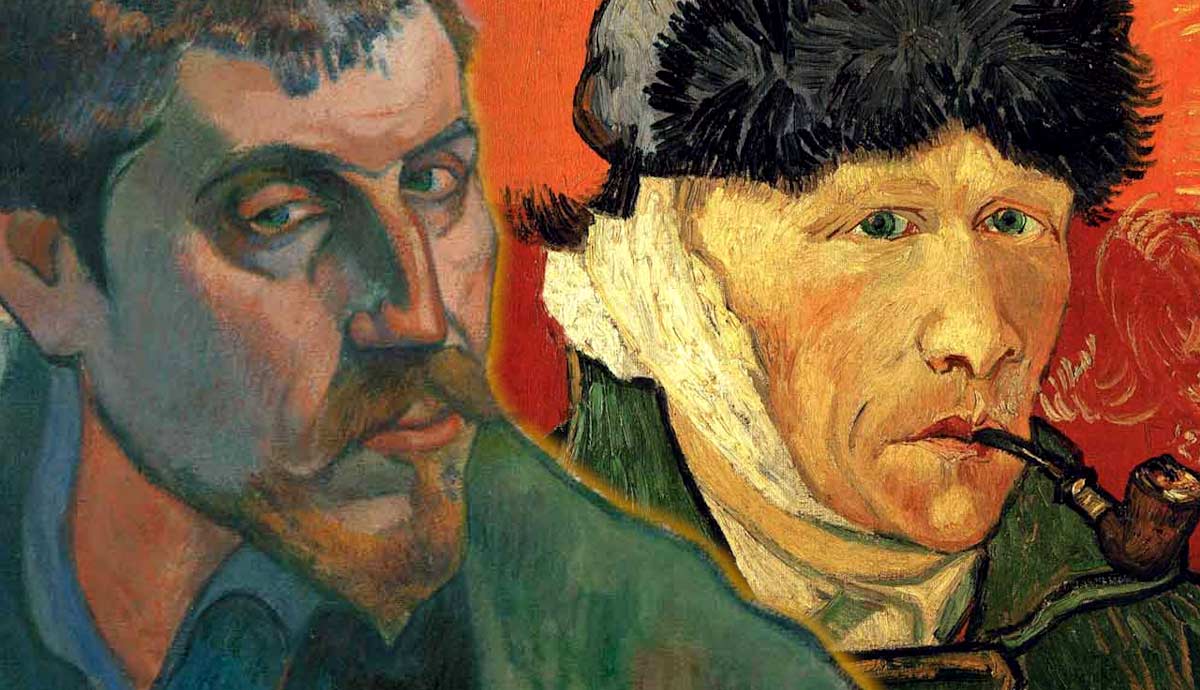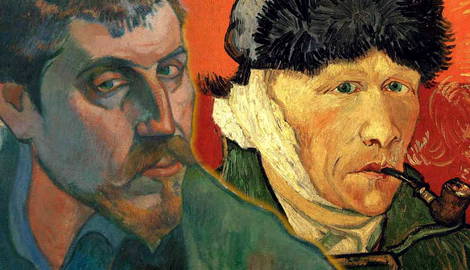
The relationship between Van Gogh (1853–1890) and Gauguin (1848–1903) is one of the most famous in art history. Both artists aimed to break away from the limitations of Impressionism that was sweeping Paris in the late 19th century. They sought new ways to express themselves as artists, and in each other, they found respect, admiration, and support. Their rocky friendship was full of disagreements and passion, but ultimately, encouragement. They pushed each other to consistently improve and develop their own unique styles that would inspire generations of successive artists.
Van Gogh and Gauguin: Initial Exchange

In late 1887, Gauguin had just returned from Martinique in the Caribbean. He had spent four months on the tropical island with fellow artist Charles Laval (1862–1894) searching for fresh inspiration. There, he produced what he saw as his best work yet. In an interview with art critic Charles Morice in 1890, Gauguin expressed the importance of this experience, saying, “I had a decisive experience in Martinique. It was only there that I felt like my real self.”
Gauguin met Vicent van Gogh and his brother Theo, an art dealer, in Paris shortly after his return from Martinique. The Van Gogh brothers were impressed with the paintings Gauguin had created in the Caribbean and purchased The Mango Trees, Martinique (1887) for their personal collection. Theo spent 400 francs on the painting, making it the most expensive acquisition he had ever made.
The older Van Gogh brother dealt in modern art and had an eye for avant-garde works. He became Gauguin’s dealer and continued to champion him over the coming years. Gauguin expressed a reciprocal appreciation for Vincent van Gogh’s art, which he encountered for the first time at his Peintres du Petit Boulevard exhibition. The two artists agreed to exchange works. Van Gogh gave Gauguin two of his early sunflower paintings in exchange for Gauguin’s On the Banks of the River, Martinique (1887).
Gauguin and Van Gogh found a kindred spirit in each other, and they supported and encouraged one another in their artistic endeavors. Both artists were pushing the boundaries of painting, wanting to move beyond the traditional and away from the naturalistic representations of Impressionism. In their correspondence, they discussed their ideas, techniques, and philosophy. Both men were influenced by Japanese art. Through their mutual support, Gauguin and Van Gogh inspired and encouraged each other to push their art to new heights.
A Studio of the South: Working Together in Arles

After two years in Paris, Van Gogh got tired of city life. He dreamed of creating a Studio of the South, where like-minded artists could live and work together. In early 1888, he left for Arles in the South of France, hoping that some of his fellow artists would travel to meet him there later. Although he had escaped the oppression of the city, Van Gogh missed his artistic friends, including Gauguin, Laval, and Emile Bernard (1868–1941). He regularly corresponded with them, continuing their lively debates about art.
In the autumn of 1888, Gauguin took up Van Gogh’s offer to join him in Arles. He was the only artist to do so, having failed to persuade Laval and Bernard to travel with him. He agreed to go only after the promise of financial support from Theo van Gogh. The time the artists spent living together was notoriously uneasy, but there is little doubt that during this period they collaborated artistically, drawing support and inspiration from each other. Van Gogh’s The Night Café (1888) and Gauguin’s Night Cafe in Arles (Madame Ginoux) (1888) show the painters’ perspectives on the same scene. Van Gogh also depicted Madame Ginoux, seen in Gauguin’s night café work, in a later piece in which he painted her in a very similar pose.
Dedicated Self-Portraits

The artists, along with their mutual friend Bernard, made self-portraits for each other shortly before Gauguin traveled to Arles. The friends often exchanged artworks along with their letters during their correspondences. Van Gogh had asked Gauguin and Bernard to paint portraits of one another. Instead, each created a self-portrait with a sketch of the other in the background and sent them to Van Gogh. Gauguin painted himself appearing serious and austere, likening himself to Jean Valjean from the novel Les Misérables. Van Gogh said it contained “not a hint of cheerfulness.” In return, Van Gogh sent a portrait of himself as a Japanese monk, inscribing it “To my friend Paul Gauguin.” Van Gogh wrote to his brother comparing the portraits, remarking, “When I put Gauguin’s conception and mine side by side, my portrait is equally serious but less desperate.”
Portraits of Each Other

During their time living and working together at the Yellow House in Arles, Gauguin and Van Gogh each created portraits of their companion. Gauguin’s Vincent van Gogh Painting Sunflowers (1888) shows Van Gogh at work on one of his paintings from the famous Sunflowers series. Van Gogh sits in front of an easel with a vase of yellow flowers in front of him. It is unlikely that Van Gogh was actually painting one of his still lifes at this moment in time, as it was December and not the season for sunflowers. The painting reflects the differing working methods of the artists. Gauguin liked to work from his imagination and the background in the painting is also imagined, whereas Van Gogh preferred to work from real life.
Van Gogh painted his Portrait of Gauguin (1888) on jute. The material was cheap and rough, so Gauguin bought a roll for the artists to share on his arrival in Arles. The coarseness of the cloth made painting on it a challenge, evident in Van Gogh’s thick application of paint. Gauguin’s Chair (1888), painted by Van Gogh, was also a kind of portrait of his friend. The novels and the candle are symbolic of Gauguin’s character. The red and green tones and night mood contrast with the yellows, blues, and daylight tones of Van Gogh’s Chair (1888). Van Gogh painted the latter as a self-portrait and a pendant to the former.
Growing Tensions

The relationship between the two artists became increasingly fraught and they disagreed over many things. Despite their respective admiration and encouragement of the other’s work, their time living together in Arles was anything but smooth. Gauguin did not share Van Gogh’s dreams of creating a Studio of the South. Tensions came to a head on the evening of 23rd of December in 1888 when tempers flared and the friends had a blazing argument. The altercation culminated in Van Gogh suffering from a severe psychotic episode, during which he severed his own ear. Some historians argue that it was Gauguin who inflicted the injury and that the pair lied to cover the truth. However, it is generally accepted that it was an act of self-harm. Following the incident, and before Van Gogh returned to the Yellow House from hospital, Gauguin left Arles. Although they continued to correspond, the artists would never see each other again.
Sunflowers

Van Gogh is inextricably linked to sunflowers. His paintings of the yellow flower are among the most famous in art history. However, sunflowers are also an important symbol of his friendship with Gauguin. It was Van Gogh’s early sunflower paintings that first impressed Gauguin, and he exchanged a painting of his for two small sunflower canvases. Knowing that Gauguin liked these paintings, Van Gogh set about creating his famous Sunflowers series while he was awaiting Gauguin’s arrival in Arles. He decorated Gauguin’s bedroom with two of these paintings. In his portrait of Van Gogh, made during their time together at Arles, Gauguin depicted his friend at work on one of his sunflower canvases. Gauguin later traveled to live and work in Tahiti. Whilst there, he asked friends to send him sunflower seeds. He grew and cut the flowers and then painted them in his Still Life with Hope (1901).
Van Gogh, Gauguin, and Post-Impressionism

Van Gogh and Gauguin bonded over their desire to push art forward and to move away from the restraints of Impressionism. Both artists sought to use color and composition expressively, imbuing their work with a personal response to the subject, rather than a simple representation of a real-life scene. Individual experience, memories, and imagination were important. Van Gogh and Gauguin became pioneers of this new movement, known as Post-Impressionism. The encouragement each received from the other undoubtedly helped to push the boundaries of their work.
While they both believed in a new way forward for art, they did not always agree on the method. Gauguin suggested Van Gogh work from imagination as he did, but Van Gogh continued to work mainly from life. However, Van Gogh’s masterpiece Starry Night (1889), painted six months after Gauguin left Arles, demonstrates his use of imagination. The scene is a mixture of the observed and the imagined, rich in personal feeling and expression. As with the other painters associated with the movement, including George Seurat (1859–1891) and Paul Cezanne (1839–1906), each artist ultimately took their work in their own direction. Whatever their differences, Van Gogh and Gauguin’s support of each other and encouragement to blaze a new path of artistic expression had a profound impact on their respective art, and that of generations of artists who followed.









